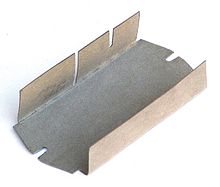Vulcanized fibre
Since 2004, the scientific community has regained interest in this material due to its renewability and excellent physical properties, giving birth to the field of all-cellulose composites.
A variety of solvents other than zinc chloride has been explored, including sodium hydroxide at low temperatures and ionic liquids.
[2][3] Whereas the original idea was to use long reinforcing fibres (ramie, flax, viscose, etc) in order to confer the composites with anisotropic mechanical properties, the field has also explored the use of nanocellulose.
As it is stronger in thin sections between mechanically rigid components, rather than relying on its own strength, it has mostly been used as washers, gaskets, and a variety of shims or packing pieces.
Fibre washers are one of the cheapest conformal elastomer gaskets for sealing pipe unions and general plumbing work.
[7] The first N.Y. corporation was also found in the 1873 N.Y. City Directory[8] which also listed William Courtenay President and Charles F. Cobby Secretary in 1873.
[14] The water power of the Piedmont streams in Northern Delaware led to a proliferation of companies in the vulcanized fibre business.
The competitors also produced bakelite, but marketed them under different names: Spaulding’s was Spauldite and National’s brand was Phenolite and Iten Industries' Resiten or Itenite.
A paper is made for saturating by omitting any sizing additive, either beater added or surface applied.
Today most paper sheets made for writing, printing, and coating have internal (beater added) sizing provided by rosin, alkyl succinic anhydride (ASA), or alkyl ketene dimer (AKD) and surface sizing provided by starch.
Once the vulcanized fibre is leached free of the zinc chloride, it is dried to 5 to 6 percent moisture, and pressed or calendered to flatness.
[citation needed] The final product is a homogeneous nearly 100%-cellulose mass free from any artificial glues, resins, or binders.
It offers high tear and tensile strength, while in the thinner thicknesses allowing flexibility to conform to curves and bends.
One application for vulcanized fibre that attests to its physical strength is that it is the preferred material for heavy sanding discs.
Physical strength is anisotropic, owing to the roller calendering process, with it typically being 50% stronger in the sheet's longitudinal direction, rather than transverse.
[16] The electrical properties exhibited by vulcanized fibre are high insulating value, and arc and track resistance with service temperature of up to 110 to 120 °C.
Vulcanized fibre shows high resistance to penetration by most organic solvents, oils, and petroleum derivatives.
